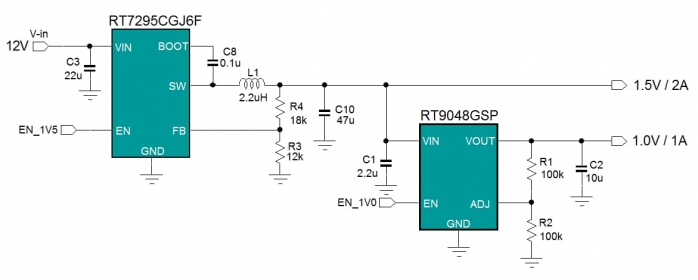What is an LDO?
An LDO, also known as a low dropout linear voltage regulator, is suitable for applications that convert a higher input voltage into a lower output voltage. The power consumption in such applications is usually not very high, and it is especially suitable for application environments that require low noise, low current, and a very small voltage difference between the input and output voltages.
Characteristics of LDOs
An LDO regulates the output voltage by controlling the conduction of the adjustment transistor in the linear region. This linear regulation method can provide a precise and noise-free output voltage and can respond quickly to changes in the load. Therefore, the main advantages of an LDO lie in its simplicity, very low usage cost and noise, as well as its fast response capability.
However, compared with switching regulators, especially in applications with a high VIN/VOUT ratio, the efficiency of an LDO is relatively low, and power consumption then becomes a rather thorny issue.
Since it adopts the linear regulation method, the power obtained by multiplying the voltage difference between the input and output by the average load current becomes the power consumption on the LDO adjustment transistor, which can be calculated as PD = (VIN - VOUT) * ILOAD. So, if there is a large difference between VIN and VOUT and there is a relatively high load current, it will lead to excessive consumption.
Higher power consumption means that the LDO requires a larger package, which increases costs, PCB space, and thermal issues in the application. When the power consumption on the LDO exceeds 0.8W, the wisest choice is to replace it with a Buck architecture converter.
LDO Applications
To select an appropriate LDO, first consider the input and output voltage ranges, its current load capacity, and the package's heat dissipation capacity. It is very important to understand the minimum dropout voltage of an LDO, as it determines the LDO's ability to maintain stable output when the voltage difference between the input and output is very small.
In micropower applications (such as some applications that use batteries for a long time), the quiescent current IQ of the LDO needs to be very low to avoid unnecessary battery consumption. In this case, a special LDO with an extremely low quiescent current is required.
In applications that require a very clean and low-noise output, low output noise and excellent PSRR parameters become the key indicators for selecting an LDO.
Common application scenarios of LDO linear voltage regulators:
(1) Converting a higher input voltage (VIN) into a lower output voltage (VOUT)
(2) Practical applications that require a very clean power supply or are sensitive to noise
(3) The VIN/VOUT ratio is not very high, for example, converting a 3.3V input into a 2.5V output
(4) Applications that do not require a large current output (usually up to 1A)
(5) The power consumption on the LDO is limited, for example, less than 0.8W
Types of LDOs
The following figure shows two common LDO circuit structures using different adjustment components: the PMOS type and the NMOS type.
PMOS Type LDO: For applications with VIN > 2.5V
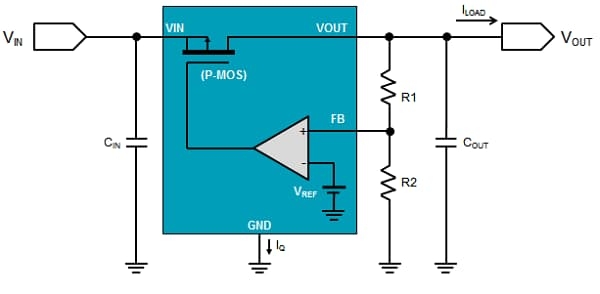
Figure 1: Basic Circuit of PMOS LDO
This is the basic circuit of a PMOS LDO, which consists of an adjustment transistor Q1, a reference voltage, and an error amplifier that controls the adjustment transistor. The error amplifier senses the output voltage through a resistive voltage divider network.
As shown in the figure, the adjustment transistor Q1 is a P-channel MOSFET, and its source is connected to the input voltage.
The control loop is very simple: the error amplifier maintains the voltage of the feedback pin at the same level as the reference voltage by controlling the gate voltage of the P-MOSFET.
When the output voltage drops due to an increase in the load or a decrease in the input voltage, the error amplifier will lower the gate voltage relative to the source, which increases the conduction level of the P-MOSFET, and the output voltage will rise back to the original stable voltage.
In this configuration, the MOSFET can be controlled to a conduction level very close to MOSFET-ON, which enables the LDO to operate normally even when VIN is very close to VOUT. However, since the gate potential cannot be lower than the ground potential, the input voltage must also be high enough to provide sufficient space for the gate-source voltage of the MOSFET to be at a normal operating level. Therefore, an LDO using a P-MOSFET as the adjustment transistor also requires a minimum input voltage of approximately 2.5V.
NMOS Type LDO: For applications with VIN > 1V (using an external bias voltage VBIAS or an internally generated bias voltage by a charge pump)
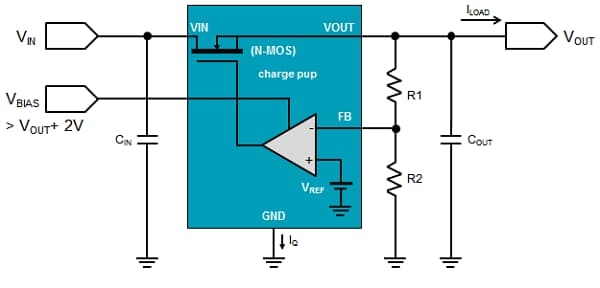
Figure 2: Basic Circuit of NMOS LDO
In some applications, you may need to drive the LDO with a very low voltage. In this case, you need to select an LDO with an N-MOSFET as the adjustment transistor.
An LDO using an N-MOSFET as the adjustment transistor requires a gate drive voltage higher than the output voltage. To achieve very low input and output voltage specifications, many N-MOSFET LDOs use an internally generated bias voltage by a charge pump circuit or an externally input bias voltage to provide the gate drive voltage, which enables these N-MOS LDOs to use a very low input voltage, such as 1V.
An N-MOSFET also has a lower on-resistance (RDS(ON)) than a P-MOSFET of a similar size, making its minimum dropout voltage lower as well. This makes it possible to output a larger current in low dropout applications.
The following figure shows an application circuit where an N-MOS LDO provides a clean and stable 1.0V output from a 1.5V low-voltage source. Since the LDO only has a voltage drop of 0.5V, it can provide more output current without excessive power consumption.
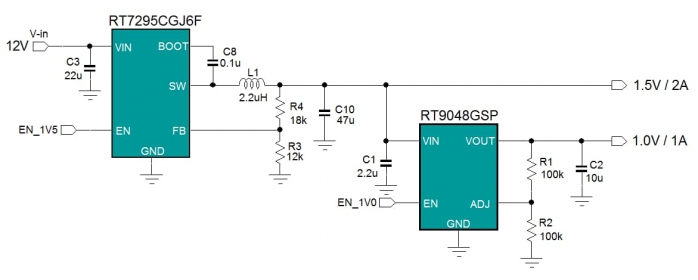
LDO Product Series
General-purpose LDOs with fixed output voltage
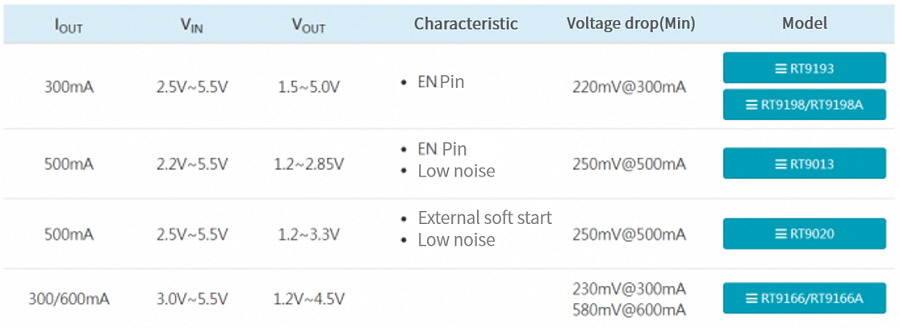
General-purpose LDOs with adjustable output voltage
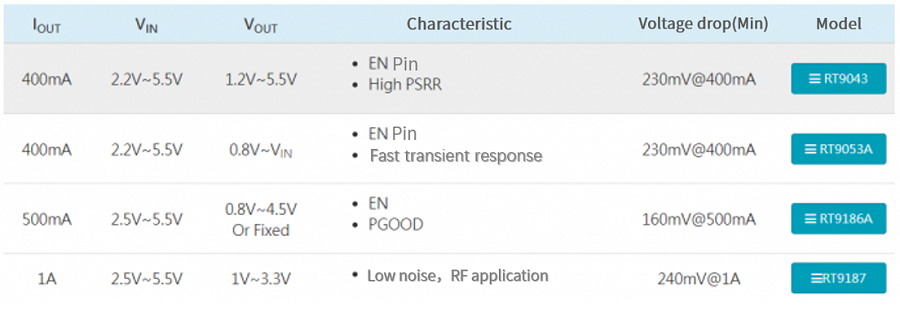
On-chip voltage regulation series for systems with low input and low output voltages
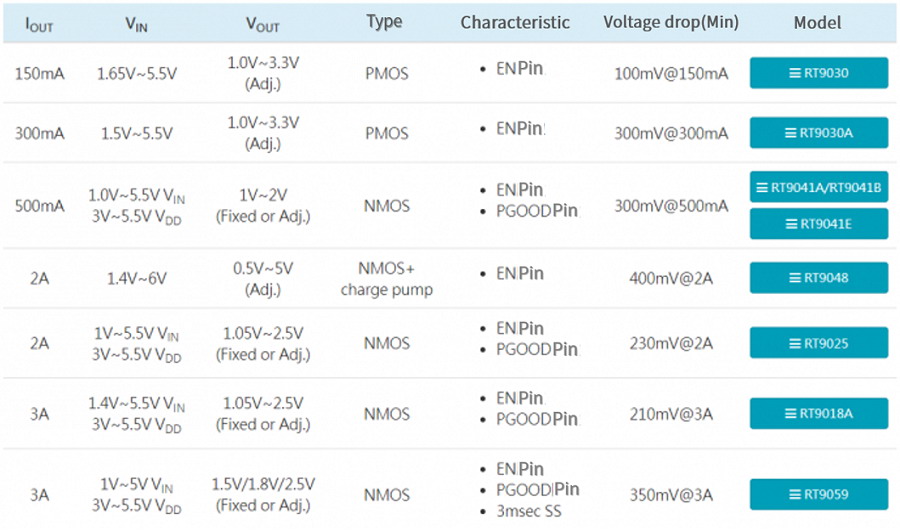
Ultra-low quiescent current series for battery applications
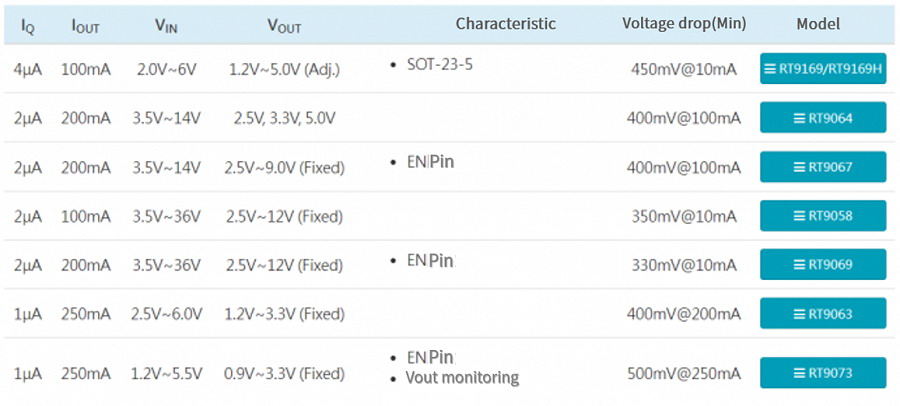
Industrial-grade LDOs (supporting a wide range of input voltages and temperature variations)

Automotive-grade LDOs
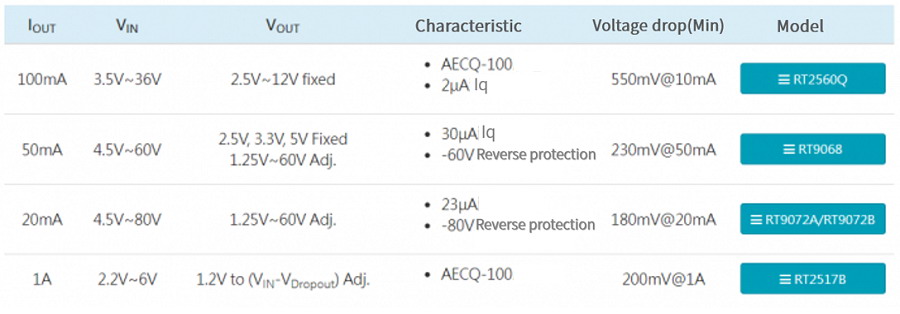
Others
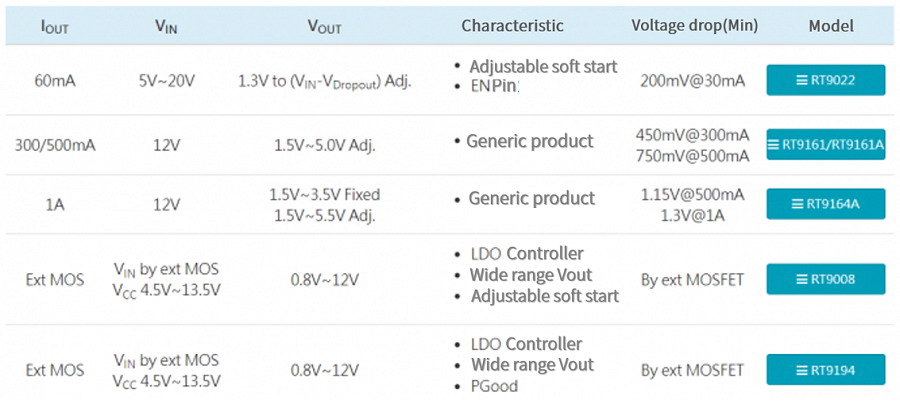
For more information about Richtek's LDO product series, please contact us.

